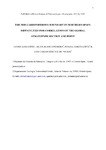The mid-carboniferous boundary in northern Spain : difficulties for correlation of the global stratotype section and point

View/
Use this link to cite
http://hdl.handle.net/2183/845Collections
- Investigación (FCIE) [1260]
Metadata
Show full item recordTitle
The mid-carboniferous boundary in northern Spain : difficulties for correlation of the global stratotype section and pointAuthor(s)
Date
2006-04Citation
Rivista Italiana di Paleontologia e Stratigrafia, vol. 112, n. 1
Abstract
The stratigraphy of latest Arnsbergian to early Chokierian (Serpukhovian/Bashkirian) is described for the Barcaliente Formation in the Cantabrian Mountains. The conodont content has been studied at the Millaró section, where the appearance of Declinognathodus noduliferus Ellison & Graves, in the lower metres of the Barcaliente Formation is confirmed, and the location of the Mississippian/Pennsylvanian boundary is discussed. The new subspecies D. noduliferus bernesgae is described and other records are also studied from the Pyrenean Azkarate section. First occurrences of Declinognathodus species are discussed from different basins, and a sequence of first appearances is applied for world-wide correlation. The lowest occurrence of D. inaequalis at the Mid-Carboniferous boundary GSSP is preferred as the primary correlation marker, because D. noduliferus s.l. includes several different taxa. Gnathodus and Lochriea species persist above the base of the Pennsylvanian and disappear in the Chokierian (early Bashkirian), as described elsewhere.
Keywords
Stratigraphy
Correlation
Conodonts
Mississippian
Pennsylvanian
Cantabrian Mountains
Pyrenees
Correlation
Conodonts
Mississippian
Pennsylvanian
Cantabrian Mountains
Pyrenees
Description
Borrador del articulo publicado por la revista con las correcciones de los revisores
ISSN
0035-6883





